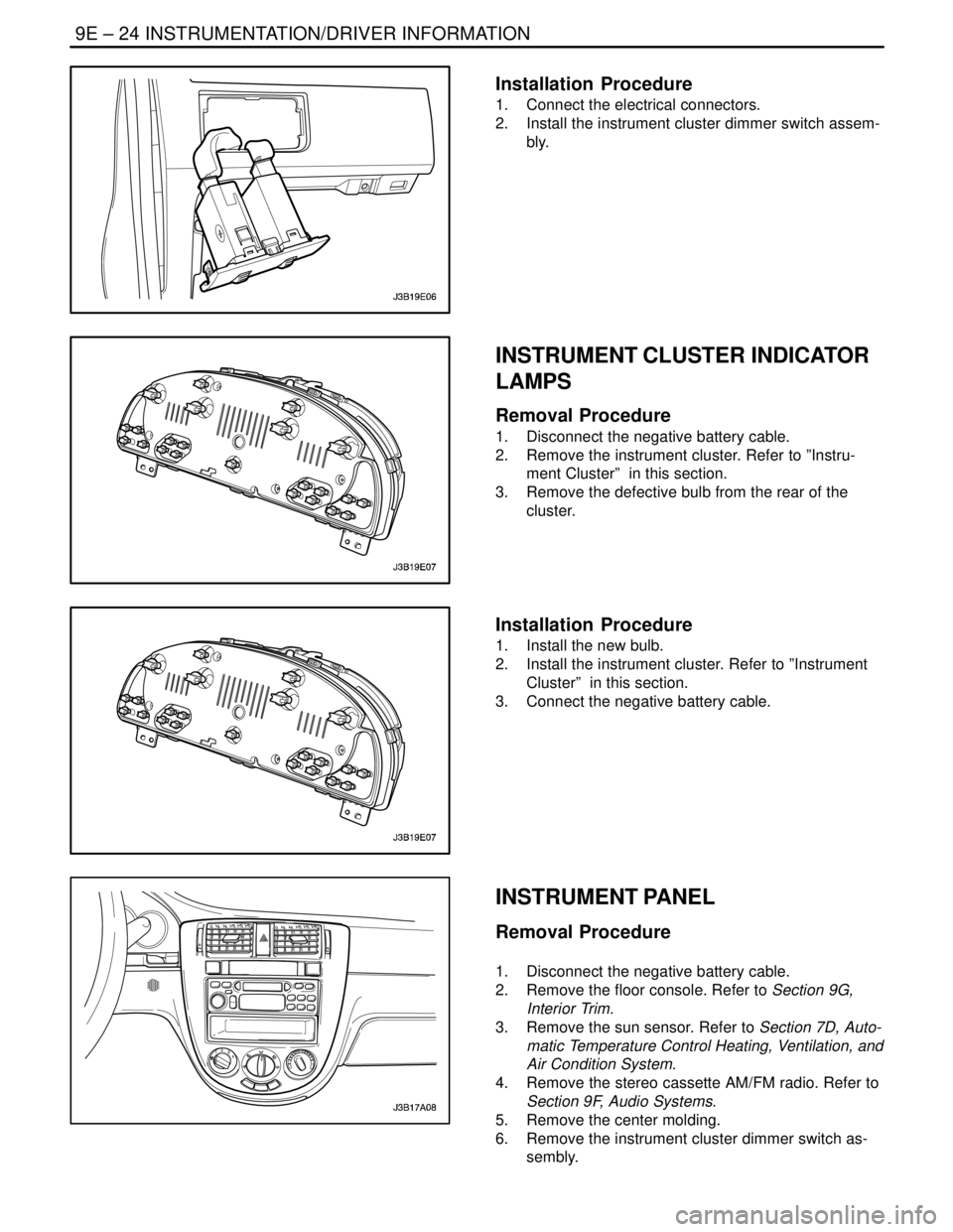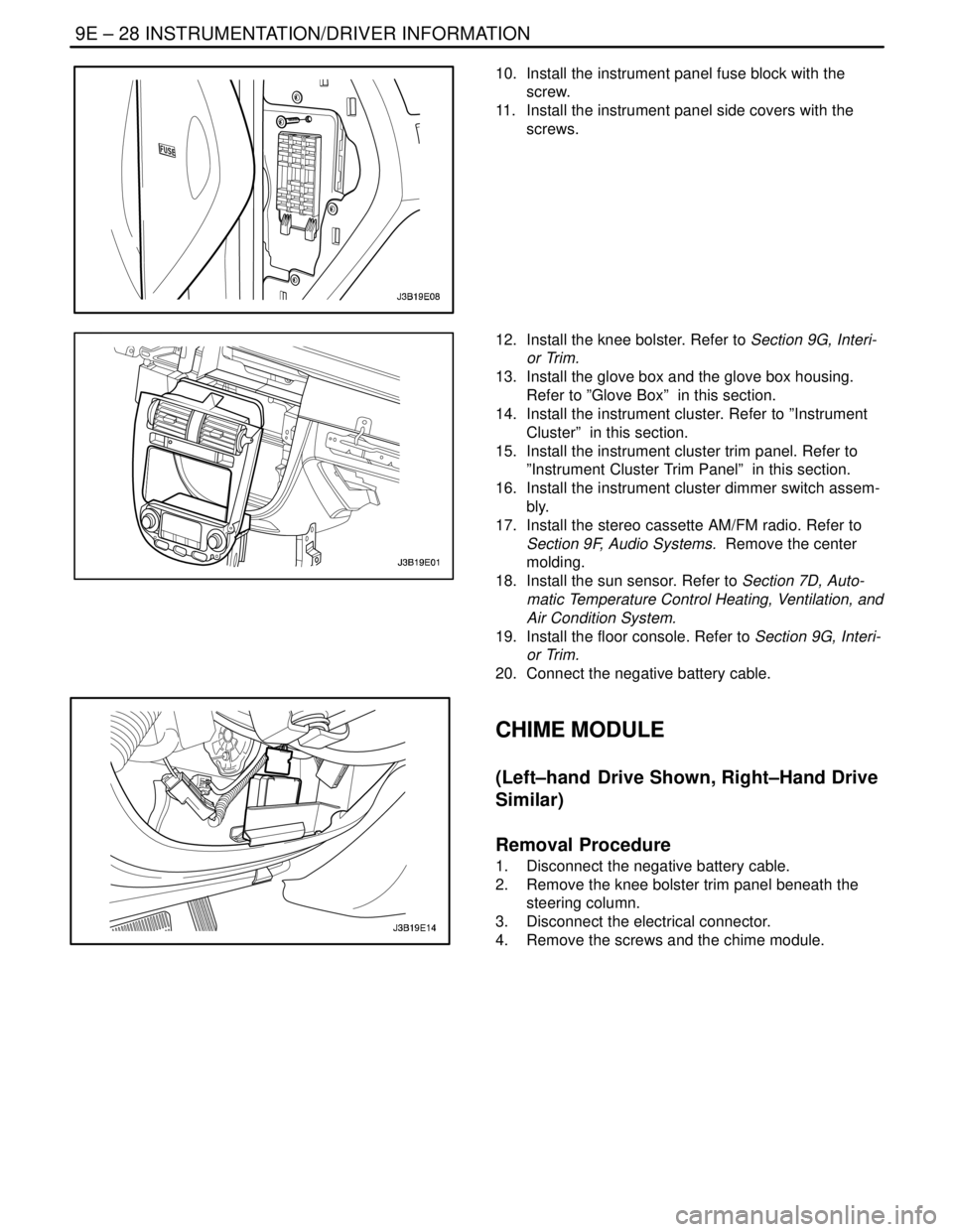2004 DAEWOO NUBIRA heating
[x] Cancel search: heatingPage 2094 of 2643

IAUTOMATIC TEMPERATURE CONTROL HEATING, VENTILATION, AND AIR CONDITIONING SYSTEM 7D – 39
DAEWOO V–121 BL4
UNIT REPAIR
V5 AIR CONDITIONING COMPRESSOR OVERHAUL
COMPRESSOR OVERHAUL
Refer to Section 7B, Manual Control Heating, Ventilation,
and Air Conditioning System for details of the following
procedures:
S Clutch Coil.
S Clutch Plate and Hub Assembly.
S Clutch Rotor and Bearing.
S Component Locator V5 Compressor.
S Control Valve Assembly.
S Cylinder to Front Head O–Ring.
S Leak Testing (External).
S Pressure Relief Valve.
S Rear Head, Gasket, Valve Plate, Reed Plate, and
O–Ring.
S Shaft Seal Replacement.
Page 2095 of 2643

7D – 40IAUTOMATIC TEMPERATURE CONTROL HEATING, VENTILATION, AND AIR CONDITIONING SYSTEM
DAEWOO V–121 BL4
GENERAL DESCRIPTION
AND SYSTEM OPERATION
GENERAL INFORMATION
THE V5 SYSTEM
Refer to Section 7B, Manual Control Heating, Ventilation,
and Air Conditioning System,for general information de-
tails for the following:
S System Components – Functional.
S The V5 A/C System.
S V5 Compressor – Description of Operation.
S V5 Compressor – General Description.
SYSTEM COMPONENTS–CONTROL
Controller
The operation of the A/C system is controlled by the
switches on the control head. This console–mounted
heating and ventilation system contains the following
knobs and display:
Temperature Control Push Knobs
1. Raise the temperature of the air entering the ve-
hicle by pressing the top switch, with the red arrow
pointing upward.
2. Lower the temperature by pressing the bottom
switch, with the blue arrow pointing downward.
3. Actuate the air mix door by an electric motor.
4. Vary the mix of the air passing through the heater
core with the air bypassing the core.
Each press of a switch changes the set temperature by in-
crements of 0.5°C (1°F). This is shown in the temperature
window on the function display.
The Function Display
This is an LCD display indicating the status of the control
settings selected. Starting from the left end of the display,
the sections are as follows:
1. Temperature setting – Indicates the temperature set
with the temperature control knob.
2. Auto status – Indicates whether the system is oper-
ating in the full auto mode or the manual mode.
3. Defroster icon – Indicates manual selection of full
defrost mode.
4. Mode – Indicated by icon, the mode chosen by the
system in auto (or by the operator in manual) is
shown by an illumination arrow indicating the air
path.
5. A/C – A snowflake icon indicating whether the A/C
is ON or OFF.
6. Fan speed – Indicates the fan speed by illuminating
a bar based on the segment at the front, for low
speed, and adding additional segments in order up
to the fifth, for high speed.Eight Additional Push Knobs
1. Full defrost – Causes the mode motors to direct all
air to the windshield and aide window outlets for
maximum defrosting.
2. Air intake – Switches between fresh air intake, the
default, and recirculating air. Airflow arrows on the
display indicate the mode in effect.
3. Full Auto Switch – Maintains the set temperature
automatically. In this mode, the fully automatic tem-
perature control (FATC) system controls the follow-
ing:
S The air mix door motor.
S The mode door motor.
S The blower motor speed.
S The inlet air door motor.
S A/C ON/OFF.
4. OFF Switch – Turns the automatic air conditioning
and fan control off.
5. Mode Switch – Allows manual selection of the air-
flow direction.
S Selection is shown on the function display.
S Each time the mode switch is pressed, the next
function is displayed.
6. A/C Switch – Allows manual selection and control
of the air conditioning function.
7. Fan Control Switch – Allows manual selection
among five fan speeds.
8. Defogger Switch – Turns on the electric defogging
heater in the rear window and the outside rearview
mirrors, if the vehicle is equipped with heated mir-
rors.
Pressure Transducer
Pressure transducer switching incorporates the functions
of the high–pressure and the low–pressure cutout
switches along with the fan cycling switch. The pressure
transducer is located in the high–side liquid refrigerant line
behind the right strut tower, between the right strut tower
and the fire wall. The output from this pressure transducer
goes to the electronic control module (ECM), which con-
trols the compressor function based on the pressure sig-
nal.
Wide–Open Throttle (WOT) Compressor
Cutoff
During full–throttle acceleration, the throttle position sen-
sor (TPS) sends a signal to the ECM, which then controls
the compressor clutch.
High RPM Cutoff
As engine rpm approaches the maximum limit, the ECM
will disengage the compressor clutch until the engine
slows to a lower rpm.
Page 2323 of 2643

9E – 24IINSTRUMENTATION/DRIVER INFORMATION
DAEWOO V–121 BL4
Installation Procedure
1. Connect the electrical connectors.
2. Install the instrument cluster dimmer switch assem-
bly.
INSTRUMENT CLUSTER INDICATOR
LAMPS
Removal Procedure
1. Disconnect the negative battery cable.
2. Remove the instrument cluster. Refer to ”Instru-
ment Cluster” in this section.
3. Remove the defective bulb from the rear of the
cluster.
Installation Procedure
1. Install the new bulb.
2. Install the instrument cluster. Refer to ”Instrument
Cluster” in this section.
3. Connect the negative battery cable.
INSTRUMENT PANEL
Removal Procedure
1. Disconnect the negative battery cable.
2. Remove the floor console. Refer to Section 9G,
Interior Trim.
3. Remove the sun sensor. Refer to Section 7D, Auto-
matic Temperature Control Heating, Ventilation, and
Air Condition System.
4. Remove the stereo cassette AM/FM radio. Refer to
Section 9F, Audio Systems.
5. Remove the center molding.
6. Remove the instrument cluster dimmer switch as-
sembly.
Page 2327 of 2643

9E – 28IINSTRUMENTATION/DRIVER INFORMATION
DAEWOO V–121 BL4
10. Install the instrument panel fuse block with the
screw.
11. Install the instrument panel side covers with the
screws.
12. Install the knee bolster. Refer to Section 9G, Interi-
or Trim.
13. Install the glove box and the glove box housing.
Refer to ”Glove Box” in this section.
14. Install the instrument cluster. Refer to ”Instrument
Cluster” in this section.
15. Install the instrument cluster trim panel. Refer to
”Instrument Cluster Trim Panel” in this section.
16. Install the instrument cluster dimmer switch assem-
bly.
17. Install the stereo cassette AM/FM radio. Refer to
Section 9F, Audio Systems. Remove the center
molding.
18. Install the sun sensor. Refer to Section 7D, Auto-
matic Temperature Control Heating, Ventilation, and
Air Condition System.
19. Install the floor console. Refer to Section 9G, Interi-
or Trim.
20. Connect the negative battery cable.
CHIME MODULE
(Left–hand Drive Shown, Right–Hand Drive
Similar)
Removal Procedure
1. Disconnect the negative battery cable.
2. Remove the knee bolster trim panel beneath the
steering column.
3. Disconnect the electrical connector.
4. Remove the screws and the chime module.
Page 2329 of 2643

9E – 30IINSTRUMENTATION/DRIVER INFORMATION
DAEWOO V–121 BL4
GENERAL DESCRIPTION
AND SYSTEM OPERATION
CIGAR LIGHTER
The cigar lighter is located in the front portion of the floor
console. To use the lighter, push it in completely. When the
lighter is hot, it will release itself from contact with the heat-
ing element. The lighter and the heating element can be
damaged if the lighter is not allowed to release itself fully
from the heating element.
ASHTRAY
The ashtray is located below the audio system. To access
the ashtray, pull it out from the center console. The ashtray
lamp will go on when the parking lamps or the headlamps
are turned on.
INSTRUMENT PANEL VENTS
The center and the side vents in the instrument panel can
be adjusted up and down and from side to side. The side
vents can also be aimed toward the side windows in order
to defog them.
GLOVE BOX
The glove box can be opened by pulling up on the latch
handle. The glove box must be removed in order to gain
access to the passenger’s side airbag module.
DIGTAL CLOCK
The digital clock is located in the instrument panel, above
the audio system. The clock is capable of a 12–hour or a
24–hour display.
INSTRUMENT CLUSTER
The instrument cluster is located above the steering col-
umn and in the instrument cluster trim panel. The instru-
ment cluster contains the instruments that provide the
driver with vehicle performance information. The instru-
ment cluster contains a speedometer, an odometer, a trip
odometer, a temperature gauge, a fuel gauge, and several
indicator lamps. For replacement of the indicator lamp
bulbs contained in the instrument cluster, refer to ”Instru-
ment Cluster Indicator Lamps Specifications” and”Instru-
ment Cluster Indicator Lamps” in this section.
SPEEDOMETER/ODOMETER/TRIP
ODOMETER
The speedometer measures the speed of the vehicle in
km/h (mph in some countries). It consists of an instrument
cluster gauge connected to the vehicle speed sensor
(VSS) on the transaxle output shaft.The odometer measures in kilometers (miles in some
countries) the total distance the vehicle has traveled since
it was manufactured. It consists of an instrument cluster
gauge connected to the VSS on the transaxle output shaft.
The trip odometer measures the distance the vehicle has
traveled since the odometer was last reset. It consists of
an instrument cluster gauge connected to the VSS on the
transaxle output shaft. The trip odometer can be reset to
zero at any time so that the driver can record the distance
traveled from any starting point.
FUEL GAUGE
The fuel gauge consists of an instrument cluster gauge
connected to a sending unit in the fuel tank.
The fuel gauge indicates the quantity of fuel in the tank
only when the ignition switch is turned to ON or ACC.
When the ignition is turned to LOCK or START, the pointer
may come to rest at any position.
TEMPERATURE GAUGE
The temperature gauge consists of an instrument cluster
gauge connected to a temperature sensor that is in con-
tact with the circulating engine coolant.
The temperature gauge indicates the temperature of the
coolant. Prolonged driving or idling in very hot weather
may cause the pointer to move beyond the center of the
gauge. The engine is overheating if the pointer moves into
the red zone at the upper limit of the gauge.
INSTRUMENT CLUSTER INDICATOR
LAMPS
The instrument cluster contains indicator lamps that indi-
cate the functioning of certain systems or the existence of
potential problems with the operation of the vehicle. The
indicator lamps are replaceable. For replacement of the in-
dicator lamps contained in the instrument cluster, refer to
”Instrument Cluster Indicator Lamps Specifications”
and”Instrument Cluster Indicator Lamps” in this section.
CHIME MODULE
The chime module is located above the instrument panel
fuse block and will sound in order to bring attention to one
or more of the following conditions:
S The lamps are on, the door is ajar, and the ignition
switch is not in ACC, ON, or START.
S The seat belt is unbuckled when the ignition switch
is in ON or START.
S The door is open when the ignition switch is in ON
or START.
S The key is left in the ignition switch when the igni-
tion is in LOCK and the door is open.
Page 2426 of 2643

9P – 6IDOORS
DAEWOO V–121 BL4
DIAGNOSIS
POWER WINDOWS
System With Only Front Power Windows, One or Both Windows
are Inoperative
CAUTION : When powering the window motors directly from a battery with jumper wires, make sure one of the
jumper wires contains a fuse. If the jumpers are accidentally touched together, the fuse will prevent sparking
and burns from sudden terminal heating.
Step
ActionValue(s)YesNo
11. Turn the ignition ON.
2. Attempt to operate both power windows.
Is either window working?–Go to
Step 18Go to
Step 2
2Visually inspect the connection at the dual
power window switch.
Is the electrical connector correctly attached
to the switch?–Go to
Step 4Go to
Step 3
3Correctly attach the electrical connector to
the dual power window switch.
Is the repair complete?–System
OK–
41. Disconnect the electrical connector from the
dual power window switch.
2. Turn the ignition ON.
3. Check the voltage at terminal 4 and 5 of the
power window main switch connector.
Is the voltage equal to the specified value?11–14 vGo to
Step 16Go to
Step 5
5Check fuses EF14 and EF9.
Is either fuse blown?–Go to
Step 6Go to
Step 7
61. Check for a short circuit and repair if neces-
sary.
2. Replace the blown fuse(s).
Is the repair complete?–System
OK–
71. Turn the ignition ON.
2. Check the voltages at fuses EF9 and EF14.
Are both voltages equal to the specified val-
ue?11–14 vGo to
Step 9Go to
Step 8
8Repair the power supply to the fuse which did
not indicate battery voltage with the ignition
on.
Is the repair complete?–System
OK–
91. Remove the power window relay.
2. Turn the ignition ON.
3. Check the voltage at terminal 30 and terminal
85 of the power window relay socket. (Termi-
nals of the relay socket can be identified by
the markings on the bottom of the relay.)
Does the voltmeter indicate the specified val-
ue at terminals 30 and 85?11–14 vGo to
Step 11Go to
Step 10
10Repair the open circuit between the fuses and
the power window relay.
Is the repair complete?–System
OK–
Page 2429 of 2643

DOORS 9P – 9
DAEWOO V–121 BL4
System With Front and Rear Power Windows, One or Both Front
Windows are Inoperative
CAUTION : When powering the window motors directly from a battery with jumper wires, make sure one of the
jumper wires contains a fuse. If the jumpers are accidentally touched together, the fuse will prevent sparking
and burns from sudden terminal heating.
Step
ActionValue(s)YesNo
11. Turn the ignition ON.
2. Attempt to operate each front power window.
Is either window working?–Go to
Step 18Go to
Step 2
2Visually inspect the connection at the power
window main switch.
Is the electrical connector correctly attached
to the main switch?–Go to
Step 4Go to
Step 3
3Correctly attach the electrical connector to
the power window main switch.
Is the repair complete?–System
OK–
41. Disconnect the electrical connector from the
power window main switch.
2. Turn the ignition ON.
3. Check the voltage at terminal 3 and 10 of the
power window main switch connector.
Is the voltage equal to the specified value?11–14 vGo to
Step 16Go to
Step 5
5Check fuses EF14 and EF9.
Is either fuse blown?–Go to
Step 6Go to
Step 7
61. Check for a short circuit and repair, if neces-
sary.
2. Replace the blown fuse(s).
Is the repair complete?–System
OK–
71. Turn the ignition ON.
2. Check the voltages at fuses Ef9 and EF14.
Are both voltages equal to the specified val-
ue?11–14 vGo to
Step 9Go to
Step 8
8Repair the power supply to the fuse which did
not indicate battery voltage with the ignition
on.
Is the repair complete?–System
OK–
91. Remove the power window relay.
2. Turn the ignition ON.
3. Check the voltage at terminal 30 and terminal
86 of the power window relay socket. (Termi-
nals of the relay socket can be identified by
the markings on the bottom of the relay.)
Does the voltmeter indicate the specified val-
ue?11–14 vGo to
Step 11Go to
Step 10
10Repair the open circuit between the fuses and
the power window relay.
Is the repair complete?–System
OK–
Page 2432 of 2643

9P – 12IDOORS
DAEWOO V–121 BL4
System With Front and Rear Power Windows, One or Both Rear
Windows are Inoperative
CAUTION : When powering the window motors directly from a battery with jumper wires, make sure one of the
jumper wires contains a fuse. If the jumpers are accidentally touched together, the fuse will prevent sparking
and burns from sudden terminal heating.
Step
ActionValue(s)YesNo
11. Turn the ignition ON.
2. Make sure that the window lock position has
not been selected on the power window main
switch.
Is either rear power window working?–Go to
Step 18Go to
Step 2
2Visually inspect the connection at the power
window main switch.
Is the electrical connector correctly attached
to the main switch?–Go to
Step 4Go to
Step 3
3Correctly attach the electrical connector to
the power window main switch.
Is the repair complete?–System
OK–
41. Disconnect the electrical connector from the
power window main switch.
2. Turn the ignition ON.
3. Check the voltage at terminal 3 and 10 of the
power window main switch connector.
Is the voltage equal to the specified value?11–14 vGo to
Step 16Go to
Step 5
5Check fuses EF9 and EF14.
Is either fuse blown?–Go to
Step 6Go to
Step 7
61. Check for a short circuit and repair, if neces-
sary.
2. Replace the blown fuse(s).
Is the repair complete?–System
OK–
71. Turn the ignition ON.
2. Check the voltages at fuses Ef9 and EF14.
Are both voltages equal to the specified val-
ue?11–14 vGo to
Step 9Go to
Step 8
8Repair the power supply to the fuse which did
not indicate battery voltage with the ignition
on.
Is the repair complete?–System
OK–
91. Turn the ignition ON.
2. Remove the power window relay.
3. Check the voltage at terminal 30 and terminal
86 of the power window relay socket. (Termi-
nals of the relay socket can be identified by
the markings on the bottom of the relay.)
Does the voltmeter indicate the specified val-
ue?11–14 vGo to
Step 11Go to
Step 10
10Repair the open circuit between the fuses and
the power window relay.
Is the repair complete?–System
OK–